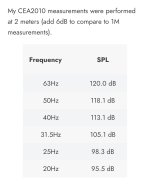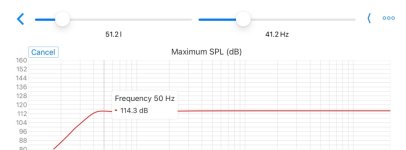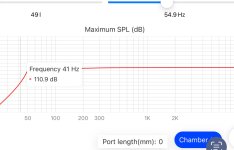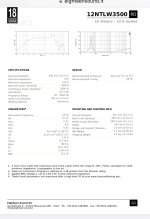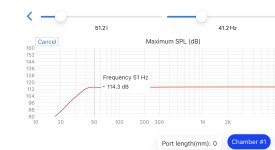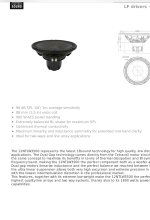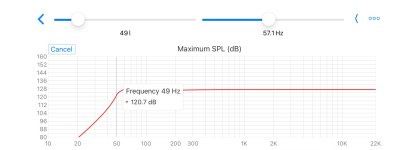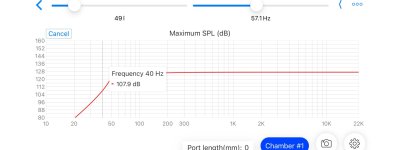Sorry about the jargon.JH> Yes they will be steep FIR filtering done in S/W on my M1 Mac mini. I currently have a Prima Luna EVO 300 integrated for mids, and Monolith 9-channel HT power amplifier used for woofers and tweeters. I also have a Job 225 which I plan to use for tweeters(used for another room system right now).
JH> Yes, I am planning to use my SVS below some point for all the channel in the system. It will be a 5.1-channel system after all.
JH> I haven't started thinking about it yet. Scanspeak and Volt are candidates, though it's wide open to others. Though I prefer pulp cones, I am curious about harder materials. I am planning a sealed one, as SVS will fill the lacking low bass and it is also a sealed box.
JH> Not sure what you mean exactly or how I can do that. We will have a lot of chat on this, too. 🙂
Let’s assume the sealed SvS sub had a 1,000 watt power amp and it’s 90 db for 1 watt at one metre. Alternatively what is its rated spl at 50 hertz ?
It might be 120 db. They will have a spec on that.
Being sealed is an advantage in mating to a mid bass woofer.
The mid bass woofer needs to be able to track the dynamic behaviour of the SVS sub. This is about efficiency and displacement. The mid bass driver is a motor pushing an air load. Dual 8 inch woofers are about the same cone area as a 12 inch woofer. But an 8 inch woofer with a response in a box to say 50 hertz is relatively less sensitive and efficient over its pass band. Say it’s 89 db. Dual 8 inch woofers are going to add +3 db. So it’s 92 and a 200 watt amp
Balancing a system is about trade offs and compromises. What you want are complimentary compromises.
Looking at objective outputs
On the subwoofer and mid base woofer(s) it’s about comparing the relative efficiency and displacement of both.
Let’s assume your SVS sub is the SB 4000. Under test it can produce at 1 metre
60 hertz 126 db
50 hertz 124 db
40 hertz 119 db
30 hertz 111 db
Looking at objective outputs
On the subwoofer and mid base woofer(s) it’s about comparing the relative efficiency and displacement of both.
Let’s assume your SVS sub is the SB 4000. Under test it can produce at 1 metre
60 hertz 126 db
50 hertz 124 db
40 hertz 119 db
30 hertz 111 db
- Room gain is an unknown variable so the above is only a guide.
- It’s assumed you are using a single subwoofer.
Attachments
Now for comparison purposes l have constructed a simple model of the Volt 2500.1 using dual 2500.1 woofers.
The woofer is rated at 250 watts
The sensitivity is 88 db
Effective efficiency increases with dual woofers. The output increases +3 db
An optimum bass reflex tuning 42 hertz in 52L enclosure (two woofers)
Parallel connection
Max spl at 50 hertz 114 db Stereo 117 db
40 hertz 112db Stereo 115db
SVS sub is the SB 4000. Under test it can produce at 1 metre
60 hertz 126 db
50 hertz 124 db
40 hertz 119 db
30 hertz 111 db
So to compare both the sub (single sub) and stereo dual volt 2500.1 there is a 6 - 7 db difference in the respective outputs at 50 hertz. This is being optimistic at the limits of the Volt drivers.
In real terms single you would need 4x more power to match the SVS sub. But the Volt drivers lack the displacement to achieve that.
The woofer is rated at 250 watts
The sensitivity is 88 db
Effective efficiency increases with dual woofers. The output increases +3 db
An optimum bass reflex tuning 42 hertz in 52L enclosure (two woofers)
Parallel connection
Max spl at 50 hertz 114 db Stereo 117 db
40 hertz 112db Stereo 115db
SVS sub is the SB 4000. Under test it can produce at 1 metre
60 hertz 126 db
50 hertz 124 db
40 hertz 119 db
30 hertz 111 db
So to compare both the sub (single sub) and stereo dual volt 2500.1 there is a 6 - 7 db difference in the respective outputs at 50 hertz. This is being optimistic at the limits of the Volt drivers.
In real terms single you would need 4x more power to match the SVS sub. But the Volt drivers lack the displacement to achieve that.
Attachments
Last edited:
Now if we look at a single 12 inch pro mid bass woofer manufactured by 18 Sound.
The trade off here is efficiency versus output at 40 hertz compared to the dual Volt 2500.1 enclosure.
This is a high performance state of art dual gap differential drive woofer with excellent mid range resolution. The impedance curve is flat through the midrange.
Enclosure tuning 58 hertz 50 L
Sensitivity 95 db
Rated power input 900 watts rms
Enclosure tuning 58 hertz 50L
Maxoutput 50 hertz 120 db stereo 123.7db
40 hertz 108 db stereo 111 db
Let’s assume your SVS sub is the SB 4000. Under test it can produce at 1 metre
60 hertz 126 db
50 hertz 124 db
40 hertz 119 db
30 hertz 111 db
As can be seen objectively the 18 Sound single woofer (8 ohms) is a closer match at hertz and above. It’s also 4 db more sensitive (91 db versus 95 db ) and an 8 ohm load compared to the 4 ohm load of the dual Volt
In practice while an 8 or a 10 inch cone woofer may seem subjectively adequate as a stand alone music loudspeaker when paired with a sub like a sealed SVS everything changes. You may find the need to raise the sub crossover point to 100 hertz so the Volt main enclosure isn’t swamped by the dynamic output of the sub. If you are using a single sub a 100 hertz cross over point may be sub optimal.
This is a displacement and efficiency problem with smaller hifi woofers.
The 18 Sound driver trades the 40 hertz output for higher efficiency and displacement in the 50 - 1000 hertz pass band. This particular driver will most likely have lower distortion due to its differential motor voice coils.
Of course considerations like the WAF need to be considered. But some work on the front baffle can overcome these potential barriers to a no holds barred system.
The trade off here is efficiency versus output at 40 hertz compared to the dual Volt 2500.1 enclosure.
This is a high performance state of art dual gap differential drive woofer with excellent mid range resolution. The impedance curve is flat through the midrange.
Enclosure tuning 58 hertz 50 L
Sensitivity 95 db
Rated power input 900 watts rms
Enclosure tuning 58 hertz 50L
Maxoutput 50 hertz 120 db stereo 123.7db
40 hertz 108 db stereo 111 db
Let’s assume your SVS sub is the SB 4000. Under test it can produce at 1 metre
60 hertz 126 db
50 hertz 124 db
40 hertz 119 db
30 hertz 111 db
As can be seen objectively the 18 Sound single woofer (8 ohms) is a closer match at hertz and above. It’s also 4 db more sensitive (91 db versus 95 db ) and an 8 ohm load compared to the 4 ohm load of the dual Volt
In practice while an 8 or a 10 inch cone woofer may seem subjectively adequate as a stand alone music loudspeaker when paired with a sub like a sealed SVS everything changes. You may find the need to raise the sub crossover point to 100 hertz so the Volt main enclosure isn’t swamped by the dynamic output of the sub. If you are using a single sub a 100 hertz cross over point may be sub optimal.
This is a displacement and efficiency problem with smaller hifi woofers.
The 18 Sound driver trades the 40 hertz output for higher efficiency and displacement in the 50 - 1000 hertz pass band. This particular driver will most likely have lower distortion due to its differential motor voice coils.
Of course considerations like the WAF need to be considered. But some work on the front baffle can overcome these potential barriers to a no holds barred system.
Attachments
It might seem weird placing a 2 inch dome mid above a 12 inch woofer. This is purely an optical problem!
I am removing HiVi and Tang Band ones, as they look inferior to other options and/or the brand/presented data seem less reliable. I am adding Visation instead. I also found Beyma and some others used to have dome midranges. Scanspeak's cheaper one has a very peaky curve, so was excluded, too.
Driver Low Fc(Hz) High Fc(Hz) Sensitivity(dB/W/m) Max Power(W) Xmax(mm) Price(USD) ATC SCM75-150 300? 2000? 91? 75 4 900? Volt VM753 450 4000 92 100(AES) 2 580 Bliesma M74S-6 500 5000 95 N/A?!?!?!? 2.4 411 Volt VM527 600 4000? 90 75(AES) 2 298 Satori MD60N-6 700 4500 93 120?(rated) 1 173 Visaton G 50 FFL 600 8000? 89 120(nominal?) ? ???
My money is on the Satori or the Bliesma. SB acoustics refer to their 2 inch done as a fil in driver meaning it’s fills the gap between a woofer and a tweeter.
If you are looking to do it first time once my pick is the Bliesma.
I’ve read too many good things in reviews and test reports about these 3 inch domes. The designer spend a long time testing different diaphragms and subjective listening before finalising the different versions. The 3 inch VC is your power handling and dynamics.
Here is an excellent test report.
The A version of the S version will work fine.
The silk version has won over some studios in the Uk who were looking at custom ATMOS monitors. They like the S version
https://hificompass.com/en/reviews/bliesma-m74a-6-m74b-6-m74p-6-and-m74s-6
Btw.
Not meaning to Hi Jack this thread. There are some real consequences when determining the the driver requirements.
Tomorrow l will outline a model of the 2 and inch 95 sb sensitivity dome mid divers in the contex lt of a 3 m listening distance.
As a pre cursor the loss over 3m is around 9 db.
Therefore if the listener determines he needs +6 more than the 85Db reference level for music when watching movies we nee to assess the implications.
For those curious. It is the peak voltage at the 3 inch driver terminals and the impact on the motional displacement diaphragm.
The motional velocity with increasing spl in the the range of 800 to 4000 hertz needs investigation.
Assessing the average spl and the peak spl at 3 m needs to be determined after normalising the driver spl a one metre
How does a 3 inch soft dome diaphragm behave under a peak spl at 1 metre of 111 db for a peak spl of 102 db a 3 metres? The average reference level at 3m is 91db for home theatre.
Technically the rms power in a narrow pass and of 800-4000 hertz is not the issue. Its the peak velocity of the voice coil in the gap versus the mass and the rigidity of dispersion and VC assembly.
Not meaning to Hi Jack this thread. There are some real consequences when determining the the driver requirements.
Tomorrow l will outline a model of the 2 and inch 95 sb sensitivity dome mid divers in the contex lt of a 3 m listening distance.
As a pre cursor the loss over 3m is around 9 db.
Therefore if the listener determines he needs +6 more than the 85Db reference level for music when watching movies we nee to assess the implications.
For those curious. It is the peak voltage at the 3 inch driver terminals and the impact on the motional displacement diaphragm.
The motional velocity with increasing spl in the the range of 800 to 4000 hertz needs investigation.
Assessing the average spl and the peak spl at 3 m needs to be determined after normalising the driver spl a one metre
How does a 3 inch soft dome diaphragm behave under a peak spl at 1 metre of 111 db for a peak spl of 102 db a 3 metres? The average reference level at 3m is 91db for home theatre.
Technically the rms power in a narrow pass and of 800-4000 hertz is not the issue. Its the peak velocity of the voice coil in the gap versus the mass and the rigidity of dispersion and VC assembly.
Last edited:
I heard a pair of SVS subs (not sure what models but they were about 100 liters size) in a Richer Sounds demo last year and boy they can shake the foundations, perfect for movie low frequency effects!
The demo was split between movies and Blu Ray concerts and bass lines were really blurred and muddy. He had set crossovers at 100 Hz and was Elac Uni-Fi UFR52 floor standers (nice actually!) and a B&W centre channel.
I would suggest crossing over your SVS sub at 60Hz or even 50Hz to your eight inch bass drivers as this will keep the accuracy in low end piano/cello etc.
Low end male vocals sound horrible if a home cinema sub gets anywhere near them.
As a reference, I've attached a sim comparing the driver I use in a mid sized (76 liter) sealed box, I use a 500 watts class AB power amp and have never needed more power, but to make it a like for like "Max power/Max output" comparison you would need a high power class D amp like ICE power, Pascal or Hypex etc.
Compared to the SVS demo (in different rooms and set up so huge variables) the Beyma sub is in a different league when playing instruments and can be crossed over up to 120 Hz without any trace of chesty/muddy male vocals. The SVS was horrible on male vocals and made all low end piano and bass sound plodding, vague and impossible to follow the notes.
The Beyma sub uses a larger driver in a smaller box to reduce cone travel which massively reduces a range of distortion, esp time domain distortions... It would be fascinating to see the CSD plot comparison of 13mm cone travel Vs 52 mm cone travel!
Sorry to waffle on about time domain distortion (most DIY guys disagreee with me!) but I believe its vitally important! Hence I suggest you keep the SVS below 50Hz to 60Hz and this will impact your choice of 8 inch bass drivers.
The demo was split between movies and Blu Ray concerts and bass lines were really blurred and muddy. He had set crossovers at 100 Hz and was Elac Uni-Fi UFR52 floor standers (nice actually!) and a B&W centre channel.
I would suggest crossing over your SVS sub at 60Hz or even 50Hz to your eight inch bass drivers as this will keep the accuracy in low end piano/cello etc.
Low end male vocals sound horrible if a home cinema sub gets anywhere near them.
As a reference, I've attached a sim comparing the driver I use in a mid sized (76 liter) sealed box, I use a 500 watts class AB power amp and have never needed more power, but to make it a like for like "Max power/Max output" comparison you would need a high power class D amp like ICE power, Pascal or Hypex etc.
Compared to the SVS demo (in different rooms and set up so huge variables) the Beyma sub is in a different league when playing instruments and can be crossed over up to 120 Hz without any trace of chesty/muddy male vocals. The SVS was horrible on male vocals and made all low end piano and bass sound plodding, vague and impossible to follow the notes.
The Beyma sub uses a larger driver in a smaller box to reduce cone travel which massively reduces a range of distortion, esp time domain distortions... It would be fascinating to see the CSD plot comparison of 13mm cone travel Vs 52 mm cone travel!
Sorry to waffle on about time domain distortion (most DIY guys disagreee with me!) but I believe its vitally important! Hence I suggest you keep the SVS below 50Hz to 60Hz and this will impact your choice of 8 inch bass drivers.
Attachments
Balancing a system is about trade offs and compromises. What you want are complimentary compromises.
Looking at objective outputs
On the subwoofer and mid base woofer(s) it’s about comparing the relative efficiency and displacement of both.
Let’s assume your SVS sub is the SB 4000. Under test it can produce at 1 metre
60 hertz 126 db
50 hertz 124 db
40 hertz 119 db
30 hertz 111 db
These numbers reflect the displacement of the sub woofer driver and the max input power 1200 watts rms, 4000 watts peak.
- Room gain is an unknown variable so the above is only a guide.
- It’s assumed you are using a single subwoofer.
Mine is older SB13 Ultra. I looked at SB 4000 PB, and it seems to be a more expensive/improved successor of mine. I think mine will show a few dB lower max SPL.
It’s a shame some drivers are either NA or priced out of the market. I am hearing noises that Be might be replaced by Textreme once fabrication techniques are refined. Some compression driver manufacturers are testing diaphragm alternatives to BE. Eminence has a novel textreme diaphragm compression driver.
I am getting a feeling that textreme may sound similar to kevlar....
Sorry about the jargon.
Let’s assume the sealed SvS sub had a 1,000 watt power amp and it’s 90 db for 1 watt at one metre. Alternatively what is its rated spl at 50 hertz ?
It might be 120 db. They will have a spec on that.
I think these relatively small subwoofers(smaller than 15" woofers in 80's) with thousands of watts in the plate amp are ELF design, and not as efficient as 90dB. The point of ELF design is using drivers below Fs, and get the flatness instead, right?
Being sealed is an advantage in mating to a mid bass woofer.
The mid bass woofer needs to be able to track the dynamic behaviour of the SVS sub. This is about efficiency and displacement. The mid bass driver is a motor pushing an air load. Dual 8 inch woofers are about the same cone area as a 12 inch woofer. But an 8 inch woofer with a response in a box to say 50 hertz is relatively less sensitive and efficient over its pass band. Say it’s 89 db. Dual 8 inch woofers are going to add +3 db. So it’s 92 and a 200 watt amp
I think at most I need 110dB at peak momentarily for my listening habit. I hope my SVS can hit that, as well as my woofers and the midbass in their respective band. Sealed midbass must be a no-brainer, and sealed 8"x2 woofer seems better, at least for the sake of consistency. I also became to like tight and dynamic bass more over last decades...
Now for comparison purposes l have constructed a simple model of the Volt 2500.1 using dual 2500.1 woofers.
The woofer is rated at 250 watts
The sensitivity is 88 db
Effective efficiency increases with dual woofers. The output increases +3 db
An optimum bass reflex tuning 42 hertz in 52L enclosure (two woofers)
Parallel connection
Max spl at 50 hertz 114 db Stereo 117 db
40 hertz 112db Stereo 115db
SVS sub is the SB 4000. Under test it can produce at 1 metre
60 hertz 126 db
50 hertz 124 db
40 hertz 119 db
30 hertz 111 db
So to compare both the sub (single sub) and stereo dual volt 2500.1 there is a 6 - 7 db difference in the respective outputs at 50 hertz. This is being optimistic at the limits of the Volt drivers.
In real terms single you would need 4x more power to match the SVS sub. But the Volt drivers lack the displacement to achieve that.
Insightful analysis. I think my SB13 Ultra is less efficient/powerful than that, and I don't need to hit that high SPL. I hope my dual 8" choice will be enough. I am currently using the sub below 70Hz. Hopefully I won't have to exploit my woofers for such low bass, in the presence of a sub via BM.
Now if we look at a single 12 inch pro mid bass woofer manufactured by 18 Sound.
The trade off here is efficiency versus output at 40 hertz compared to the dual Volt 2500.1 enclosure.
This is a high performance state of art dual gap differential drive woofer with excellent mid range resolution. The impedance curve is flat through the midrange.
Enclosure tuning 58 hertz 50 L
Sensitivity 95 db
Rated power input 900 watts rms
Enclosure tuning 58 hertz 50L
Maxoutput 50 hertz 120 db stereo 123.7db
40 hertz 108 db stereo 111 db
Let’s assume your SVS sub is the SB 4000. Under test it can produce at 1 metre
60 hertz 126 db
50 hertz 124 db
40 hertz 119 db
30 hertz 111 db
As can be seen objectively the 18 Sound single woofer (8 ohms) is a closer match at hertz and above. It’s also 4 db more sensitive (91 db versus 95 db ) and an 8 ohm load compared to the 4 ohm load of the dual Volt
In practice while an 8 or a 10 inch cone woofer may seem subjectively adequate as a stand alone music loudspeaker when paired with a sub like a sealed SVS everything changes. You may find the need to raise the sub crossover point to 100 hertz so the Volt main enclosure isn’t swamped by the dynamic output of the sub. If you are using a single sub a 100 hertz cross over point may be sub optimal.
This is a displacement and efficiency problem with smaller hifi woofers.
The 18 Sound driver trades the 40 hertz output for higher efficiency and displacement in the 50 - 1000 hertz pass band. This particular driver will most likely have lower distortion due to its differential motor voice coils.
Of course considerations like the WAF need to be considered. But some work on the front baffle can overcome these potential barriers to a no holds barred system.
Thank you for the advice. I am afraid the WAF problem won't go away, so feeling that maybe I should build a sub as the next project to beat SVS SB13 Ultra. I heard many times that bass from larger woofers in their high-efficiency FR sounds better and more natural than these ELF design subs. I think I recently experienced that with Scanspeak 13" woofers in 2 DIY speakers. It's an interesting topic to think about separately.
I heard a pair of SVS subs (not sure what models but they were about 100 liters size) in a Richer Sounds demo last year and boy they can shake the foundations, perfect for movie low frequency effects!
The demo was split between movies and Blu Ray concerts and bass lines were really blurred and muddy. He had set crossovers at 100 Hz and was Elac Uni-Fi UFR52 floor standers (nice actually!) and a B&W centre channel.
I would suggest crossing over your SVS sub at 60Hz or even 50Hz to your eight inch bass drivers as this will keep the accuracy in low end piano/cello etc.
Low end male vocals sound horrible if a home cinema sub gets anywhere near them.
As a reference, I've attached a sim comparing the driver I use in a mid sized (76 liter) sealed box, I use a 500 watts class AB power amp and have never needed more power, but to make it a like for like "Max power/Max output" comparison you would need a high power class D amp like ICE power, Pascal or Hypex etc.
Compared to the SVS demo (in different rooms and set up so huge variables) the Beyma sub is in a different league when playing instruments and can be crossed over up to 120 Hz without any trace of chesty/muddy male vocals. The SVS was horrible on male vocals and made all low end piano and bass sound plodding, vague and impossible to follow the notes.
The Beyma sub uses a larger driver in a smaller box to reduce cone travel which massively reduces a range of distortion, esp time domain distortions... It would be fascinating to see the CSD plot comparison of 13mm cone travel Vs 52 mm cone travel!
Sorry to waffle on about time domain distortion (most DIY guys disagreee with me!) but I believe its vitally important! Hence I suggest you keep the SVS below 50Hz to 60Hz and this will impact your choice of 8 inch bass drivers.
I don't use the SVS or any sub over 100Hz for my main with Volt B2500.1 woofers. Like you, I had my music teacher wife(majored in cello) listened to some test materials, and she complained right away with high crossover points. I also agree with her, though I seem less sensitive or have worse hearing. My brain also tells me that using subwoofers in the higher bass isn't good. But I had to set the crossover point between the SVS and MG1.7i at 100Hz, as the maggies' bass are so weak compared to dynamic type woofers'.
As I replied to macka, I might want to do a subwoofer, or maybe a side-firing big 'subwoofer' modules behind the 8" bass module. Since we don't care as much about the look of drivers that big, I think I will look at a lot of professional driver options.
Yes, my experience has led me to the point where I now strongly favor sealed box loading with a Q of 0.5 or lower.
Always Pro drivers with fabric surround and low Qts, low Mms and high Bl.
There are lots of great drivers at affordable prices that work really well with this simple recipe.
The ELF loading is my second choice if you need the smallest box and have enough amplifier power.
The better / more powerful / accurate DSP you can afford makes a bigger difference than $100 or so difference on a driver.
Always Pro drivers with fabric surround and low Qts, low Mms and high Bl.
There are lots of great drivers at affordable prices that work really well with this simple recipe.
The ELF loading is my second choice if you need the smallest box and have enough amplifier power.
The better / more powerful / accurate DSP you can afford makes a bigger difference than $100 or so difference on a driver.
There's also the Faital HF1460.Eminence has a novel textreme diaphragm compression driver.
Measures excellent for a "large" format compression driver.
Sorry for my waffling on also. It’s an exciting project.
What size is your room for this system?
If l am correct you want to use it for home theatre fronts and stereo left and right?
If this is the case then maybe aim for the left and right main enclosures to cover down to say 35 hertz like a Watt Puppy. You really don’t need the ELF theatre sub for music.
Purposing your front left and right as primarily for music greatly simplified your project!
I agree a sub for music is quite a challenge.
I have a pair of Creative Sound 12 inch subs not assembled yet. It will be interesting to see how they perform.
What size is your room for this system?
If l am correct you want to use it for home theatre fronts and stereo left and right?
If this is the case then maybe aim for the left and right main enclosures to cover down to say 35 hertz like a Watt Puppy. You really don’t need the ELF theatre sub for music.
Purposing your front left and right as primarily for music greatly simplified your project!
I agree a sub for music is quite a challenge.
I have a pair of Creative Sound 12 inch subs not assembled yet. It will be interesting to see how they perform.
https://www.madisoundspeakerstore.c...eas-excel-w22ny-003-e0097-08-8-nextel-woofer/
Out of curiosity l googled a Seas Nextel 8 inch woofer.
The above link describes the woofer under a sealed enclosure (Qtc=0.5) and a ported enclosure Fb= 28 hertz.
Suggested box alignments:
Out of curiosity l googled a Seas Nextel 8 inch woofer.
The above link describes the woofer under a sealed enclosure (Qtc=0.5) and a ported enclosure Fb= 28 hertz.
Suggested box alignments:
- Vb 14 liters (0.5 cf3) internal volume sealed and stuffed, F3 about 68 Hz
- Vb 40 liters (1.4 cf3) internal volume vented, Fb 28 Hz, F3 39 Hz, single port 2" x 5.6"
- Vb 70 liters (2.5 cf3) internal volume vented, Fb 23 Hz, F3 35 Hz, single port 2" x 4.5"
- Vb 95 liters (3.3 cf3) internal volume vented, Fb 21 Hz, F3 39 Hz, single port 2" x 4"
It occurred to me that such a woofer may be suitable on as it could be used as a sealed and a ported design using dual drivers.
The Legend Acoustics Kantu monitors l previously owned used dual 6.5 inch Scan woofers with both a sealed and a ported enclosure.
http://www.legendspeakers.com.au/products-kantu-be/
http://www.legendspeakers.com.au/products-kantu14/
I had an earlier version. It was a very complete loudspeaker
This company also has hi end active systems using DEQX
The Legend Acoustics Kantu monitors l previously owned used dual 6.5 inch Scan woofers with both a sealed and a ported enclosure.
http://www.legendspeakers.com.au/products-kantu-be/
http://www.legendspeakers.com.au/products-kantu14/
I had an earlier version. It was a very complete loudspeaker
This company also has hi end active systems using DEQX
You are right on the implementation.Very interesting way of saying dimensions. Can I take this that the lower band drivers have smaller diffraction problems even with the same size baffles? So they can be on the plain rectangular baffle and still have relatively small problems. I hope this holds good for midrange as well. Fewer cylinders, easier making.
I wish I could replace the faceplate of the tweeter or somehow mount it without one. The 21mm tweeter I want to use has a smaller faceplate than 30mm-ish tweeters', but still relatively larger. They have one with almost no faceplate area, but the FR curve isn't as good as the one I like.
If I use ATC or Volt, I guess not much to worry about thanks to the waveguides.
As you are using dsp the drivers can be aligned.
The proximity of the tweeter to the mid range dome can effect coherence. However with steep FIR filters this may be less important. Referring to the design below the face plates have not been modified.
It uses steep crossover filters.
The designer explains in this link the reasons for choosing a four way system. In particular the mid bass driver. I thought you might find this working design useful to sound (sorry)out your ideas.
As diy audio amateurs l sometimes wonder if we over think some of the details while being oblivious to factors that critically define the subjective performance. The key is understanding what really matters in the sea of information we collect in our research.
The designer here in this link previously worked at Linn, has qualifications in metallurgy and has won numerous awards.
http://www.legendspeakers.com.au/about-us-2/
http://www.legendspeakers.com.au/products-tikandi-grande/
Last edited:
" As diy audio amateurs l sometimes wonder if we over think some of the details while being oblivious to factors that critically define the subjective performance. The key is understanding what really matters in the sea of information we collect in our research. "
Well said Macka, totally agree.
I believe even a beginner can get 80% or more of the sonic quality of a professional house for 20% of the cost. ie a £10K design for £2K in 5 easy steps:.
(1) Watch some You tube videos and ask some questions here on DIY audio.
(2) Decide your budget, approx max size of cabinets and where you want them in the room ie Placed against a wall / in corners, on a wall or even in a wall or a few feet away from the wall if open baffle.
(3) Buy good quality high efficiency Pro drivers, as big as will fit into your cabinets and put them in sealed boxes with Q of 0.4 to 0.6 depending on how big / efficient you / WAF want. Or open baffle. and dont worry about the details.
(4) Use as good a DSP/crossover as you can afford and spend a few evenings / weekends watching tutorial videos on crossover and Eq'ing.
(5) Get your cabinets CNC'd and finished professionally if you dont like joinery.
Enjoy the music and the next 5 years of free time which you will have to invest if you want to master all the hundreds of details that the professionals have learned....And all these "black art" tricks combined only buys you a small upgrade in sound qaulity...Thats a fair trade for DIY!
Well said Macka, totally agree.
I believe even a beginner can get 80% or more of the sonic quality of a professional house for 20% of the cost. ie a £10K design for £2K in 5 easy steps:.
(1) Watch some You tube videos and ask some questions here on DIY audio.
(2) Decide your budget, approx max size of cabinets and where you want them in the room ie Placed against a wall / in corners, on a wall or even in a wall or a few feet away from the wall if open baffle.
(3) Buy good quality high efficiency Pro drivers, as big as will fit into your cabinets and put them in sealed boxes with Q of 0.4 to 0.6 depending on how big / efficient you / WAF want. Or open baffle. and dont worry about the details.
(4) Use as good a DSP/crossover as you can afford and spend a few evenings / weekends watching tutorial videos on crossover and Eq'ing.
(5) Get your cabinets CNC'd and finished professionally if you dont like joinery.
Enjoy the music and the next 5 years of free time which you will have to invest if you want to master all the hundreds of details that the professionals have learned....And all these "black art" tricks combined only buys you a small upgrade in sound qaulity...Thats a fair trade for DIY!
- Home
- Loudspeakers
- Multi-Way
- 4-way instead of 3-way?
